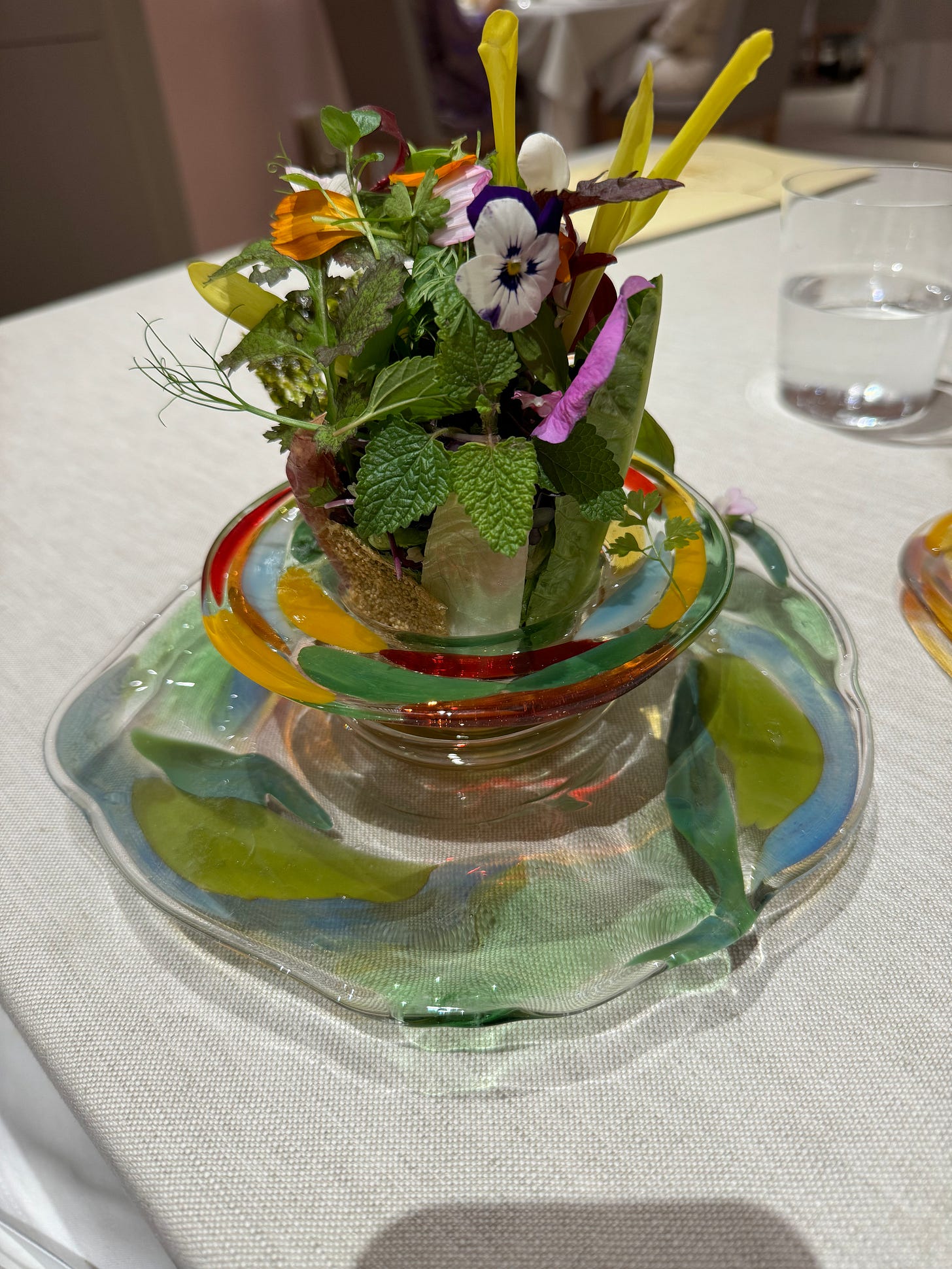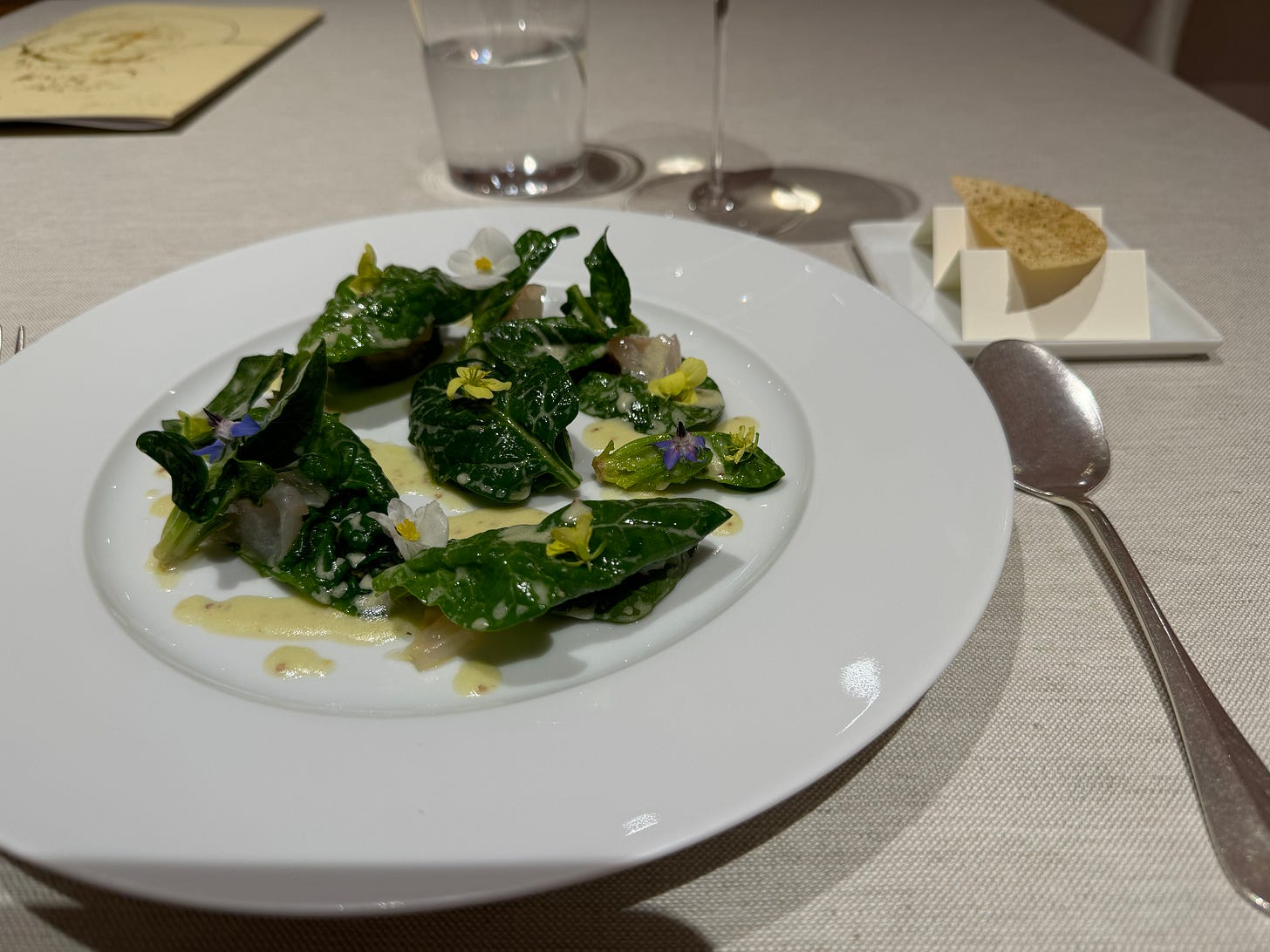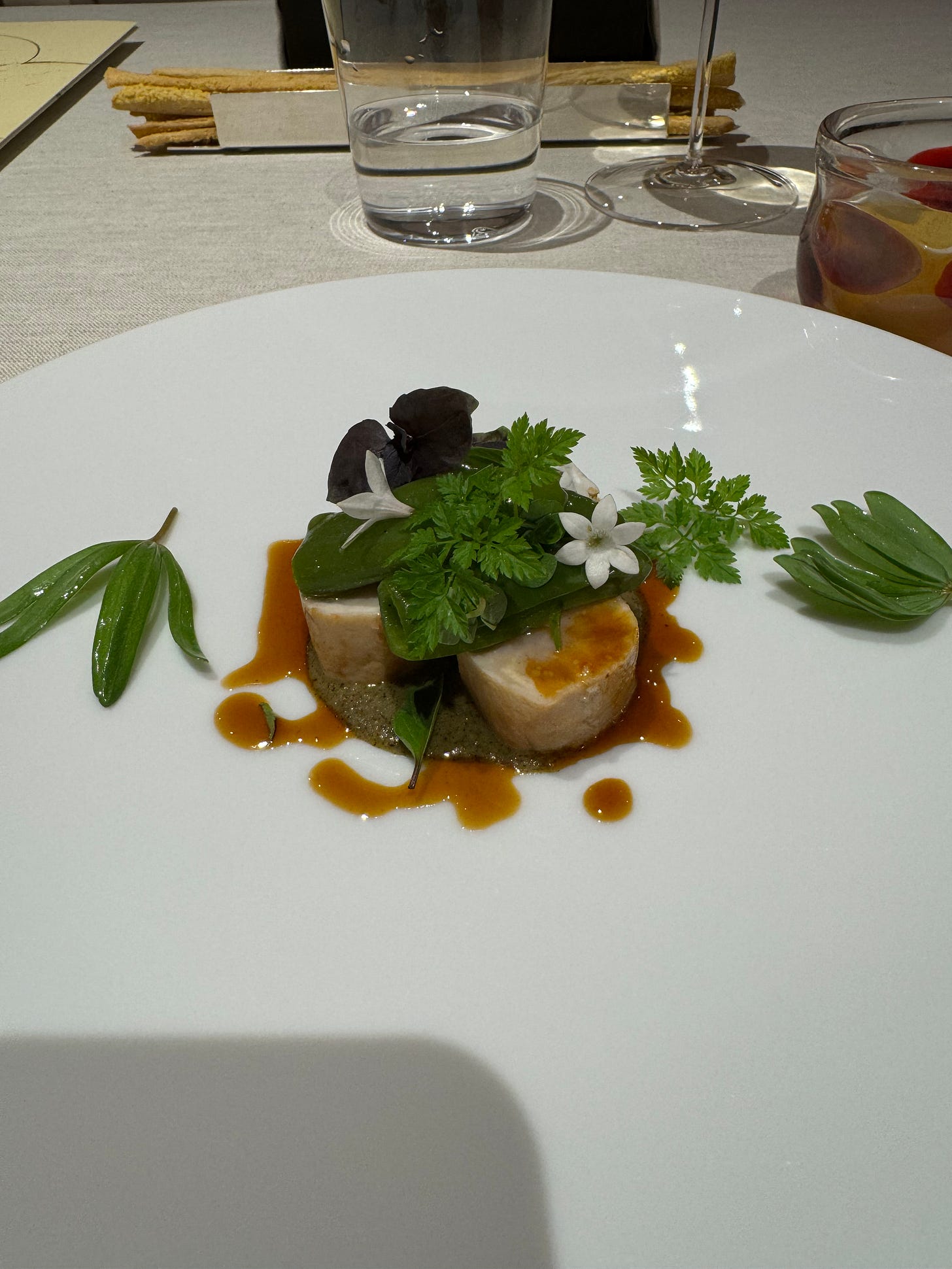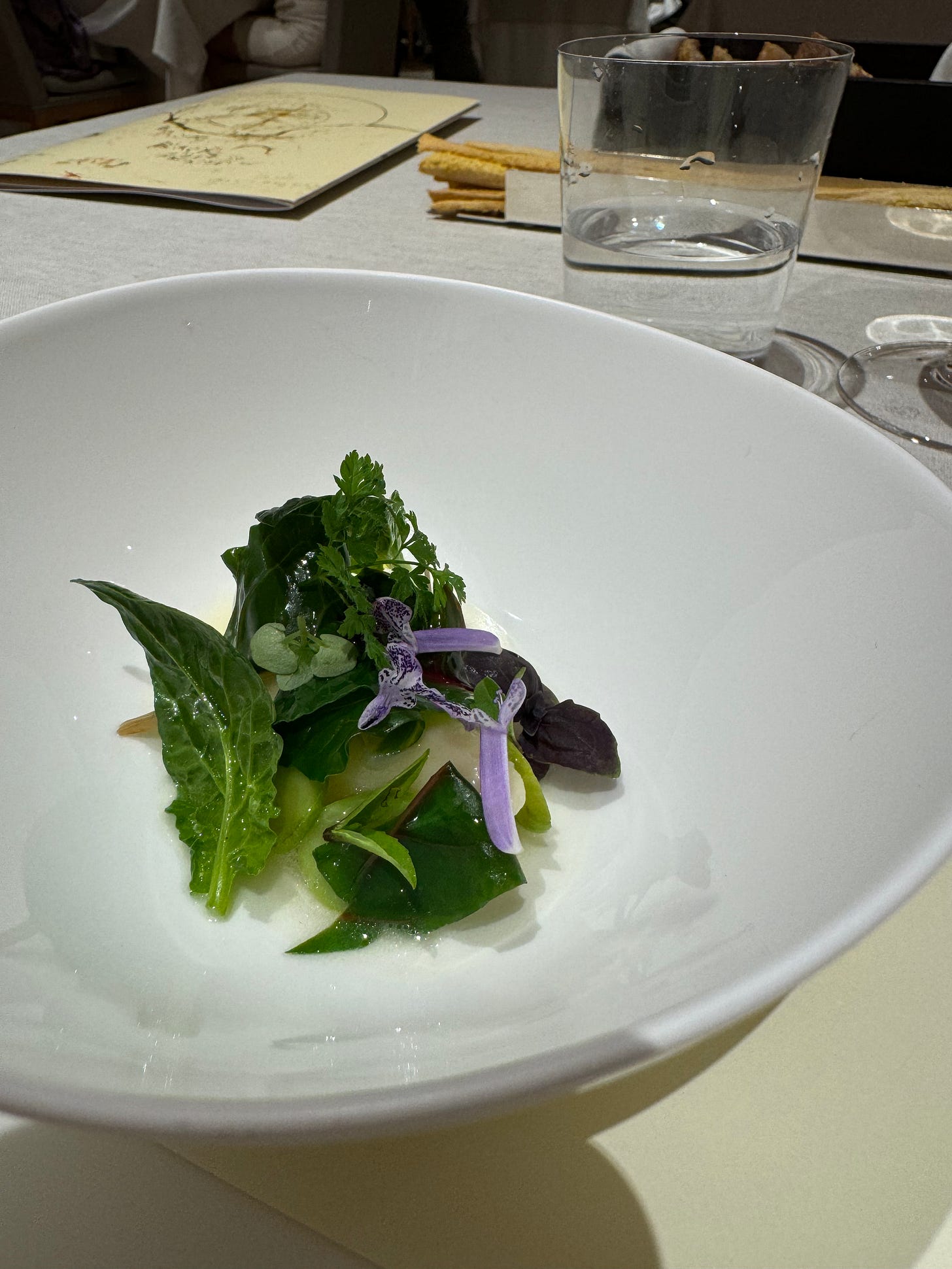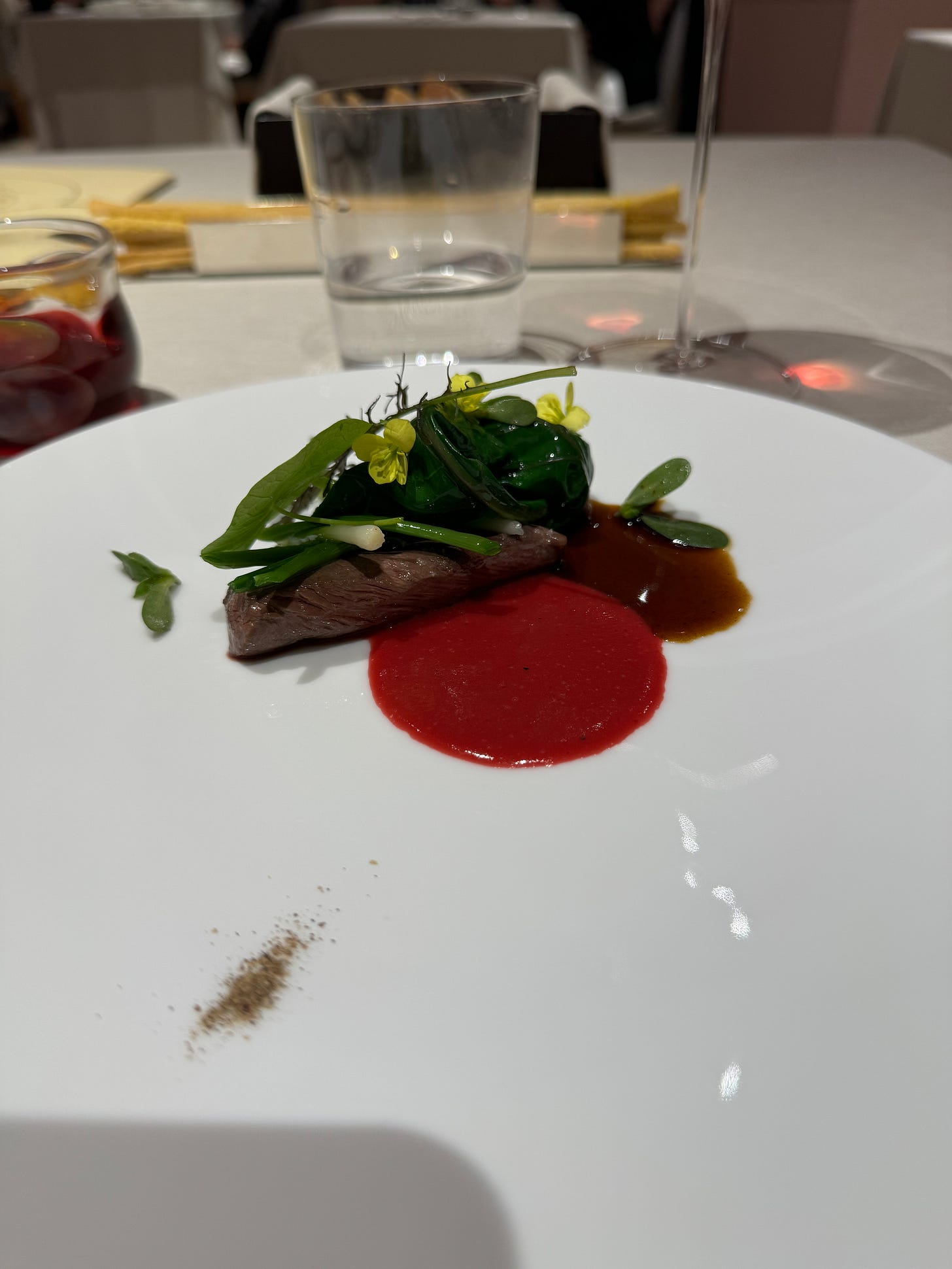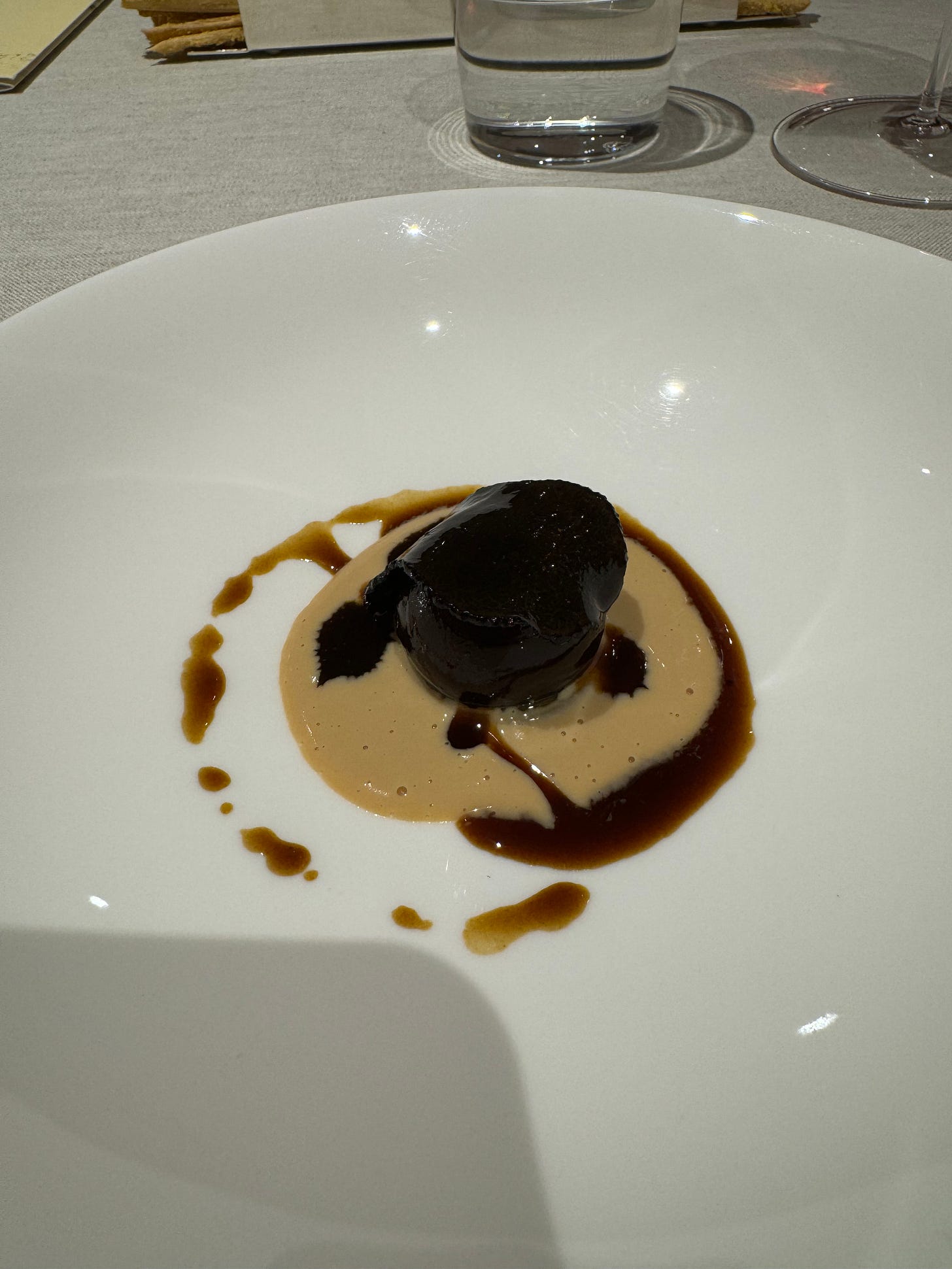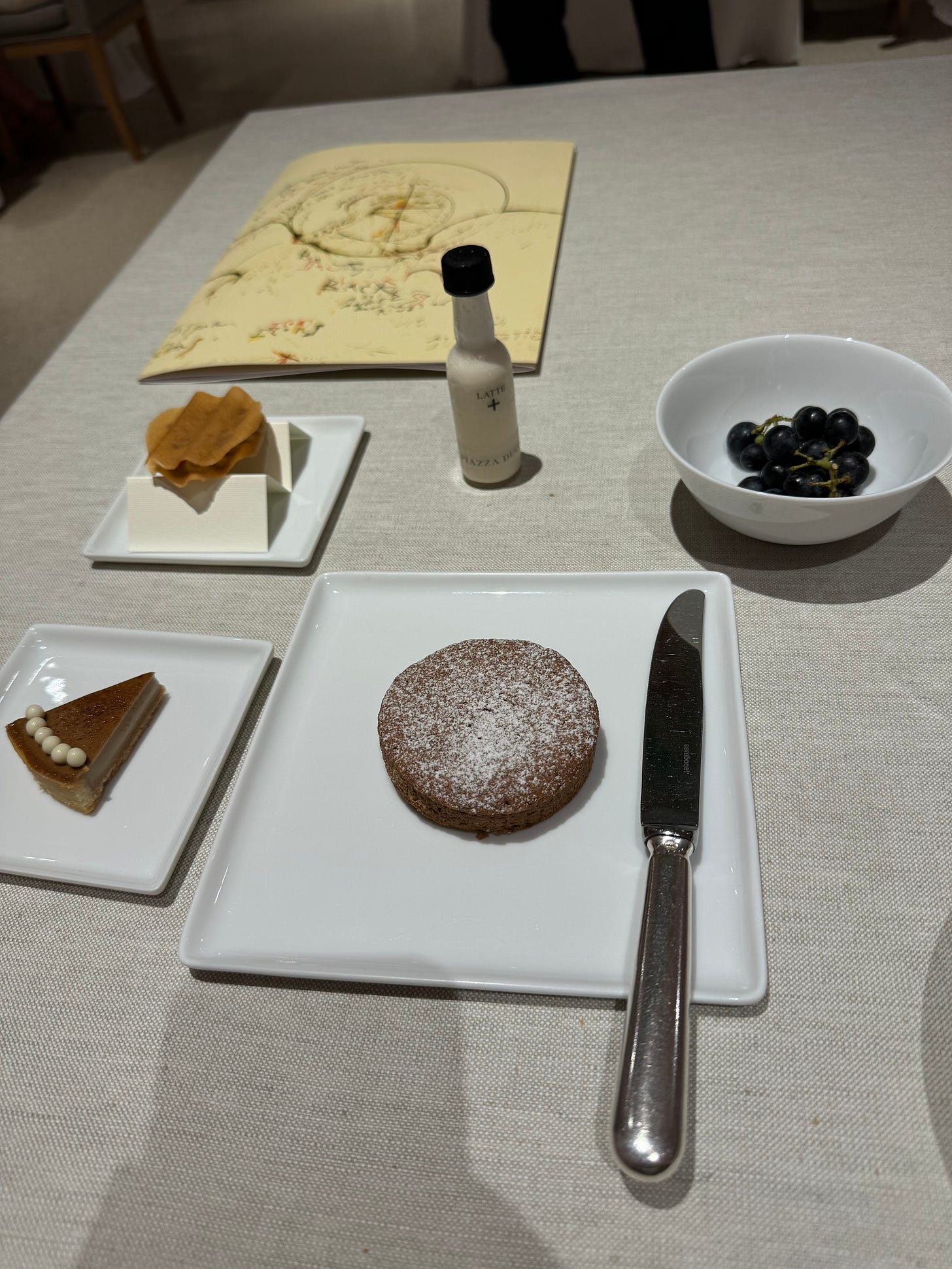Alba is such, such a pretty spot, and this was really the first time this trip I regretted not having a car for Europe because the whole Langhe region is full of pretty little towns and it would’ve been so nice to drive around a bit. But we’re not here for whistful travel tales, we’re here for food!
Chef Enrico Cripps is pretty legendary, so Piazza Duomo was the restaurant I’d known about most before this trip, and I think was the first spot I decided would definitely be part of the tour. So let’s see what it was like!
1. Welcome
Okay, so this was the chef’s – and I quote – “little welcome” (this is a man after my Mother’s heart). This one will take some work, but I’ve used my mad photo editing skills to subtley insert the key to these plates:
a. Onion bread, to go with
b. Veal terrine and pickled baby onion
c. Ricotta w/ tomato sauce
d. Pak Choy w/ green bearnaise sauce
e. Daikon fermented in miso broth w/ grated parmigiano
f. Beef intestine w/ green herb sauce
g. Chickpea taco w/ shrimps and guacamole
h. Crispy pastrami sandwich that goes with
i. Pastrami broth
j. Zucchini dumpling w/ fig oil
k. Amaranth sprouts with grapeseed mayonnaise and grapes
All delicious, my particular favourites were the super umami daikon and the two presentations of pastrami, which really leaned into the spices used in the curing process.
2. Salad 21…31…41…51…
THE iconic dish of Piazza Duomo, and one that has to be ordered in addition to the menu, this dish kicked off a real fashion for raw vegetable presentations in high end restaurants when it first appeared. It’s called this because it started with 21 ingredients but has kept growing. On the list they gave me, I counted the current number of actual ingredients to be 108. I won’t pretend I could immediately identify every individual flavour, but the fun was in the general sense of the unknown with each bite. You’d have a normal-ish bite of salad then get a big hit of wasabi spice, and then on the next bite something floral and sweet, then something more astringent and bitter. For all that restaurants can surprise you when they present dishes, there’s rarely a dish that can surprise you as you eat it the way this did.
The vase is actually sitting in a little bowl of dashi broth, which you drink at the end to refresh your palette.
3. Spinach
Consists of slivers of sea bream carpaccio, fresh spinach leaves, mustard vinaigrette, and a baked cracker studded with whole spices.
Interesting to highlight the spinach as the star of this dish, which was a nice balance between the sweet, slightly warm dressing, the fresh, vegetal leaves, the briny fish, and the warm, earthy spices in the cracker.
4. Prawns
Look at this work of art! The painted flower is made up of prawn bisque, sea urchin cream, and a green situation I didn’t catch the name of. They’re topped with an orange sauce, then raw prawns and seaweed. On the side are a cracker made with furikake (an umami rich seasoning powder from Japan) and a broth made of the prawn shells.
The sauces are nice, you get a real ocean-y flavour from the bisque, sweetness from sea urchin, and freshness from the orange, but it’s when you get some of the prawns themselves it really swings; they add both some body to what’s otherwise just soup, and also a brighter sweetness that connects the more disparate flavours of the sauces. The cracker adds umami depth. The shot of broth had a salty, sweet, and rich flavour of the roasted shells.
5. Turbot
Never had turbot before, turns out there’s a reason it’s one of the most in-demand high-end fish around. It’s meaty, with a light flavour, really nice. It’s served with a broccoli sauce that is, I think, just lightly cooked then liquidised broccoli, which added vegetal freshness, while the cabbage leaves on top had some more peppery cruciferous flavour. Big surprise was the presence of molé, which is underneath the fish as well as dotted beside it, which was warm and sweet and earthy and brought real depth and colour to an otherwise very light dish.
6. Rabbit
Rolled rabbit leg, small green peppers, rabit jus, and a broth made with bell peppers on the side. I don’t recall if I’ve had rabbit before… the leg meat was sweet and savoury, supported by the deep and sweet reduction sauce, and contrasted nicely by the crunchy, slightly zesty, green peppers.
You’ll probably note as I did that Chef Crippa is a big fan of “broth on the side” as a culinary tactic. I think it’s success across the meal varies, this one I wasn’t crazy about. It was sweet and a little vegetable-y, but I think something with more of the veggie freshness or astringency would’ve offered some more contrast.
7. Gnocchi
Rather than a handful of small dumplings as I expected, I got one big one, stuffed with a local ricotta, and topped with baby spinach and herbs. The dough itself was slightly bouncy and chewy, a bit like a Chinese dumpling skin, while the ricotta was surprisingly rich and cheesy, not like the bland nonsense I’m used to. Vegetal bitterness from the spinach, as well as crunch, for contrast, and some light prickles of herb to round it out, very nice, very demure.
8. Hare
Roasted lion of hare was sweet, rich and just a little gamey, baby leeks, chard and nasturtium leaves add grassy and peppery notes, the red sauce is a puree of borscht, which adds earthy sweetness of beetroot and umami from beef bones, while the reduction jus is more overtly sweet and sticky and rich.
The broth on the side doesn’t always work, but it did in a huge way here, the borscht consommé (in the background on the left) was one of my favourite things the whole night, such depth of flavour, somehow more so than actual borscht, earthy, umami, sweet, everything this dish wanted to say in a little cup, it added real thrust to the dish.
9. Royale
Part two of the hare, this is a royale – a set puree of stewed hare’s leg, topped with a slice of black truffle that kinda blenda into the jelly coating in the picture, foie gras cream and more hare jus.
Royales are usually lighter, made with vegetables or light veal or chicken broths, but this was awesome, super punchy and rich, the really deep and dark flavours in the royale itself and the jus complemented by the lighter sweet and savoury notes of the goose liver and the earthy truffle, which added but didn’t overwhelm as truffle can.
10. Cauliflower
A “risotto” (seriously, this is three for three on restaurants serving me risottos that aren’t actually risottos, when did we cancel risotto?) of cauliflower tips simmered in almond cream, with liquorice and burnt lemon powder on top, and toasted almond slivers.
I was ready to write this one off before I tasted it, it seemed a bit insubstantial, but actually it was really tasty, sweet and nutty from both the cauliflower and the almond, added sweet anise from the liquorice, some bitterness and astringency from the lemon powder. A nice way to transition from the richness of the mains to the sweets.
11. Quince
In the main bowl are globs of chestnut jelly, quince jelly, and tropical fruit jelly, dripped with orange sauce. This single element is the part of the whole meal I felt the most underwhelmed by. Nice general fruitiness but nothing that particularly stood out as exciting or interesting, either as a flavour or conceptually, and it’s all kinda one big soft texture. Nice, gentle, kind of blah.
On the side are a little shot of quince consommé (broth on the side) and quince sorbet. The consommé was fine, the sorbet was by far the best bit of this dish, really flavourful, and something in the quince itself or in the making gave it a really nice sticky, gooey consistency. Really liked this bit.
12. Tribute to the Artist (that’s what the dish is called)
From the ridiculous to the sublimely ridiculous. The artist in question is Vincent van Gogh, specifically his painting “Flower Beds in Holland”. On the bottom is a milk caramel sauce, then a layer milk ice cream, then rice pudding, topped with the freeze-dried milk granules you see, each with its own flavour profile: rose (pink), saffron (yellow), chamomile (brown), mint (green) and peaflower (blue).
This one was so good, the caramel on the bottom provided depth and richness, the rice adds body, the ice cream adds the lighter sweetness of fresh milk, and the frozen powders on top add little pops of fresher flavours, though never too strongly. I particularly enjoyed the pockets of mint and rose. Really great low concept dessert.
13. Mignardises
Mignardises, or petit fours, are the little surprise bites upon which you end the meal. Usually it’s like, one chocolate and one fruit jelly, one or two tiny little bits for the road. Enrico Crippa gave me a whole dessert trolley – truly a man after my Mother’s heart.
This is really a celebration of legendary Piedmontese hazelnuts, with the crunchy hazelnut cake at the bottom, and bunet (a set custard not unlike a crème caramel, this one set within a shortcrust pastry) next to it both rich with hazelnut sweetness.
Above the bunet is a sandwich of gavottes (wafer thin sweet biscuits) filled with caramel and sea salt – super delicious.
Then there are tiny little grapes - I think he said merlot grapes but I can’t be sure, I feel like wine grapes shouldn’t be as sweet and moreish as these were?
And the little bottle is Chef’s take on the Korova+ from A Clockwork Orange because obviously. Rather than dangerous stimulant drugs, I’m assured that this bottle of Korova+ contained milk, aged grappa made with Moscato grapes, and vanilla, which made it more sedative than the film version.
And that was Piazza Duomo; there were some major stand-out dishes, some very good ones, and one or two that were good but I dunno if three-Michelin-star good. This is kinda on me, I took the seasonal menu, which changes constantly based on what’s available week-by-week and day-by-say, rather than the classic menu, which has been honed and perfected over years.
While it’s awesome to see how the Chef constructs dishes without time to meticulously R&D them, and it gives you a great sense of the place and time you’re having the meal with the particular meats and veggies used, I feel like Chef Crippa is a big ideas kinda chef, he likes being able to be really playful and ironic, like with the tributes to van Gogh and Kubrick (which, you’ll note, were not season-specific), and I don’t think you can really do that in this mode.
I’d like to come again and try the classic menu (or maybe get here at the right time to try the white truffle menu) to see what more development time does for the presentation.






